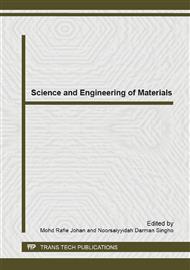p.293
p.299
p.304
p.308
p.312
p.317
p.320
p.324
p.328
The Effect of Wollastonite Filler on Thermal Performance of Intumescent Fire Retardant Coating
Abstract:
Various types of intumescent fire retardant coatings (IFRCs) have been used to protect the substrates exposed to fire. In current study, high temperature filler Wollastonite (W) filler was used to improve fire performance of intumescent fire retardant coating. The basic ingredients of the coating were ammonium poly-phosphate (APP) as acid source, expandable graphite (EG) as carbon source, melamine (MEL) as blowing agent in epoxy binder, boric acid as additive and hardener as curing agent. In this study a range of coating formulations were developed by using different weight percentages of Wollastonite filler. The coated steel substrate samples were tested for fire performance using Bunsen burner and char expansion was measured using furnace fire test. Composition of the char was determined by X-ray diffraction (XRD) technique. The char morphology was studied using field emission scanning electron microscopy (FESEM). Results showed that Intumescent coating with addition of Wollastonite filler enhanced anti-oxidation of the char. Presence of phosphorus, calcium and silicon in char layer further improved the thermal stability of char.
Info:
Periodical:
Pages:
328-331
Citation:
Online since:
June 2014
Price:
Сopyright:
© 2014 Trans Tech Publications Ltd. All Rights Reserved
Share:
Citation:


